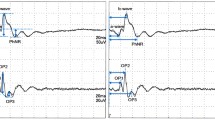Summary
Automatic intravenous infusion of fluorescein with constant speed during 25 sec is followed by a gradual increase of fluorescein in the retinal arteries and in the disc tissue. The slope of this increase Sd divided by the maximum fluorescein Md in an area of the disc S d /M d is called Fd, the same for a retinal artery is called Fr. Fr was found to be independent of intraocular pressure in the range examined (mean pressures 15–30 mm applanantion). Fd/Fd=Ω, the “fluorescein appearance rate” is correlated to the linear velocity of blood in the capillaries of the observed disc area and hence to its circulation. Ω was found to be diminished in 6 out of 9 cases with ocular tension between 26 and 38 mm applanation, but not in 3 cases. It was not diminished in 4 cases with 22–25 mm applanation. Further studies are necessary to elucidate these findings suggesting some adaptation of disc circulation to intraocular pressure but not proving it: fluorescence from vessels behind the lamina cribrosa has the tendency to seemingly “normalise” Ω.
Zusammenfassung
Injiziert man intravenös ganz gleichmäßig Fluoreszein während längerer Zeit (25 sec) statt, wie üblich, plötzlich, so steigt in Netzhautgefäßen und in der Papille die Fluoreszenz allmählich an; die Front der Fluoreszenz ist vor allem durch Farbstoffdiffusion unscharf geworden. Der Quotient (F) Anstiegstangente dividiert durch Plateau der Fluoreszenzintensität ist durch Diffusion und Blutlängsgeschwindigkeit an den Meßstellen bestimmt. Ω, das Verhältnis des Quotienten für ein Papillenareal Fd zu dem Quotienten für Netzhautarterien F r, also F d /F r ist somit ein Maß für die „relative Längsgeschwindigkeit des Stroms“ in den Papillenkapillaren. Fr ist im untersuchten Tensionsbereich (15–33 mm appl) vom Augendruck unabhängig. Verminderung von Ω bedeutet also verminderte Längsgeschwindigkeit des Blutes in den Papillenkapillaren. Bei der Mehrzahl der Augen mit Drucken zwischen 26 und 33 mm appl, aber ohne pathologische Excavation oder Gesichtsfelddefekte war dies der Fall. Bei einigen dieser Fälle war hingegen Ω normal, ebenso bei den wenigen Fällen mit Augendruck zwischen 22 und 25 mm app. Die Fluoreszenz der Papille stammt nun nicht nur von Gefäßen, die unter dem Einfluß des intraocularen Druckes stehen, sondern auch von tieferen, die ihm nicht unterliegen (retrolaminäre Gef.) Ihre Fluoreszenz verändert das Ω gegen normale Werte hin. Da wir die Größe dieses Einflusses auf das Ω nicht bestimmen konnten, bleibt vorläufig offen, ob das normale Ω in den erwähnten Fällen mit erhöhtem Druck durch jene fälschende Fluoreszenz verursacht ist oder eine Regulation der Papillenzirkulation andeutet.
Similar content being viewed by others
References
Alm, A., Bill, A.: Ocular and optic nerve blood flow at normal intraocular pressures in monkeys (macaca irus). Exp. Eye Res. 15, 15–29 (1973)
Ben Sira, J., Riva, Ch.E.: Fluorescein diffusion in the human optic disc. Invest. Ophthal. 14, 205–211 (1975)
Goldmann, H.: Fluorescein in the human optic disc. Graefes Arch. 194, 243–251 (1975) Printing error in this paper: The heading of column 2 Table 2 should be: f(p)E and not f(a)E.
Grayson, M.C., Laties, A.M.: Ocular localisation of sodium fluorescein. Arch. Ophthal. 85, 600–609 (1971)
Illi, R., Boesch, P.: Hoher Augendruck und Fluoresceinangiogramm der Papille. (Diss. Bern in Druck)
Author information
Authors and Affiliations
Additional information
We thank Mrs. Doebeli and Miss Broekhuizen for their precious help.
Rights and permissions
About this article
Cite this article
Goldmann, H., Cabernard, E. Fluorescein in the human optic disc. Albrecht von Graefes Arch. Klin. Ophthalmol. 200, 123–131 (1976). https://doi.org/10.1007/BF00414361
Received:
Issue Date:
DOI: https://doi.org/10.1007/BF00414361




